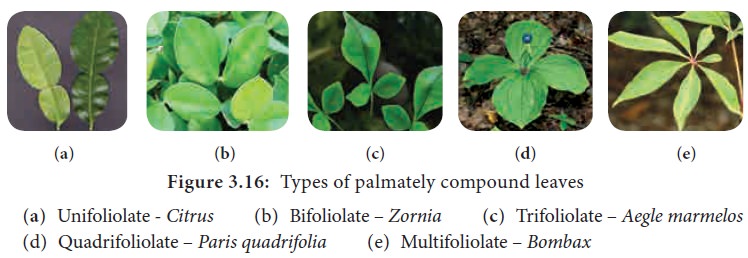Botany - Leaf type | 11th Botany : Chapter 3 : Vegetative Morphology of Angiosperm
Chapter: 11th Botany : Chapter 3 : Vegetative Morphology of Angiosperm
Leaf type
Leaf type
The pattern of division of a leaf into discrete
components or segments is termed leaf type.
Based on the number of segments
I. Simple leaf
A leaf is said to be simple when the petiole bears
a single lamina; lamina may be entire (undivided) Example: Mango or incised to
any depth but not upto the midrib or petiole. Example: Cucurbita.
II. Compound leaf
Compound leaf is one in which the main rachis bears
more than one lamina surface, called leaflets.
Compound leaves have evolved to increase total lamina surface. There is one
axillary bud in the axil of the whole compound leaf. The leaflets however, do
not possess axillary buds.
1. Pinnately compound leaf
A pinnately compound leaf is defined as one in
which the rachis, bears laterally a number of leaflets, arranged alternately or
in an opposite manner, as in tamarind, Cassia.

i. Unipinnate:
The rachis is simple and
unbranched which bears leaflets directly on its sides in alternate or opposite
manner. Example: Rose, Neem. Unipinnate leaves are of two
types.
·
when the leaflets are even in number, the leaf is
said to be paripinnate. Example: Tamarindus, Abrus,
Sesbania, Saraca, Cassia.
·
when the leaflets are odd in number, the leaf is
said to be imparipinnate. Example: Rosa, Azadirachta
(Neem), (Murraya Chinese box).
i.
Bipinnate:
The
primary rachis produces secondary
rachii which bear the leaflets. The secondary rachii are known as pinnae. Number of pinnae varies
depending on the species. Example: Delonix,
Mimosa, Acacia nilotica, Caesalpinia.
ii. Tripinnate: When the rachis branches thrice the leaf is called tripinnate. (i.e) the secondary rachii
produce the tertiary rachii which bear the leaflets. Example: Moringa, Oroxylum.
iii. Decompound: When the rachis of leaf is branched several times it
is called decompound. Example: Daucus carota, Coriandrum sativum,
Foeniculum vulgare.
2. Palmately compound leaf
A palmately compound leaf is defined as one in
which the petiole bears terminally, one or more leaflets which seem to be
radiating from a common point like fingers from the palm.
i. Unifoliolate: When a single leaflet is articulated to the petiole is said
to be unifoliolate. Example: Citrus, Des
modium gangeticum.
ii. Bifoliolate: When there are two leaflets articulated to the petiole it
is said to be bifoliolate. Example: Balanites
roxburghii, Hardwickia binata, Zornia diphylla
iii. Trifoliolate: There are three leaflets articulated to the petiole it is said
to be trifoliolate. Example: wood apple (Aegle
marmelos), Clover (Trifolium), Lablab, Oxalis
iv. Quadrifoliolate: There are four leaflets articulated to the petiole it
is
v. Multifoliolate
or digitate: Five or more
leaflets are joined and spread like fingers from the palm, as in Ceiba pentandra, Cleome pentaphylla, Bombax
ceiba

Related Topics